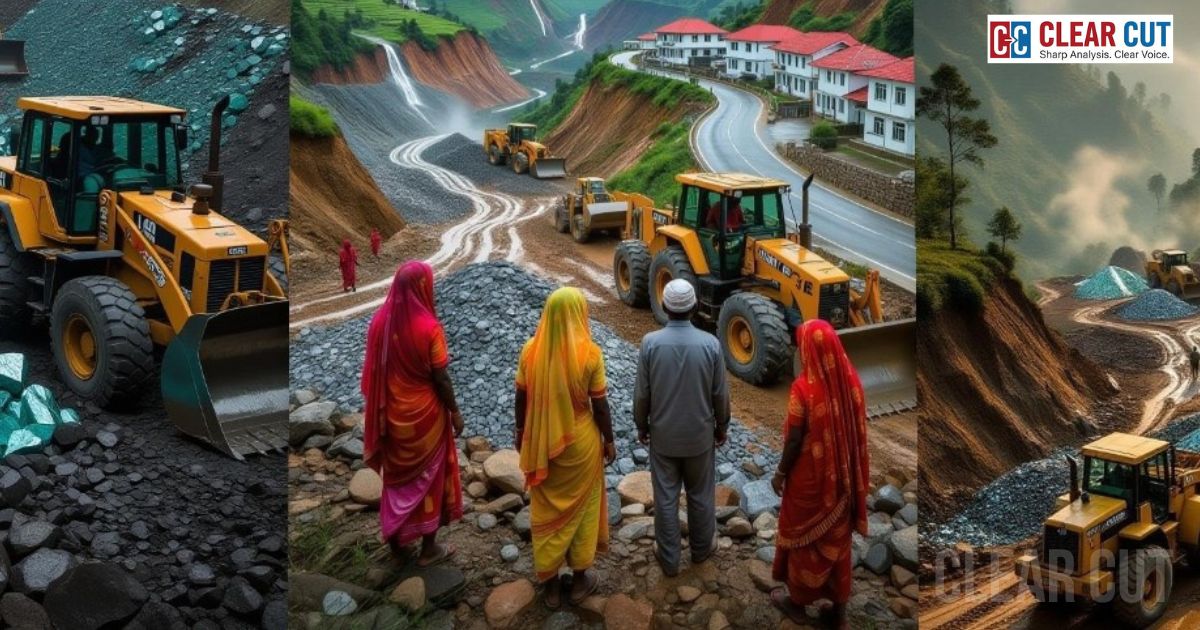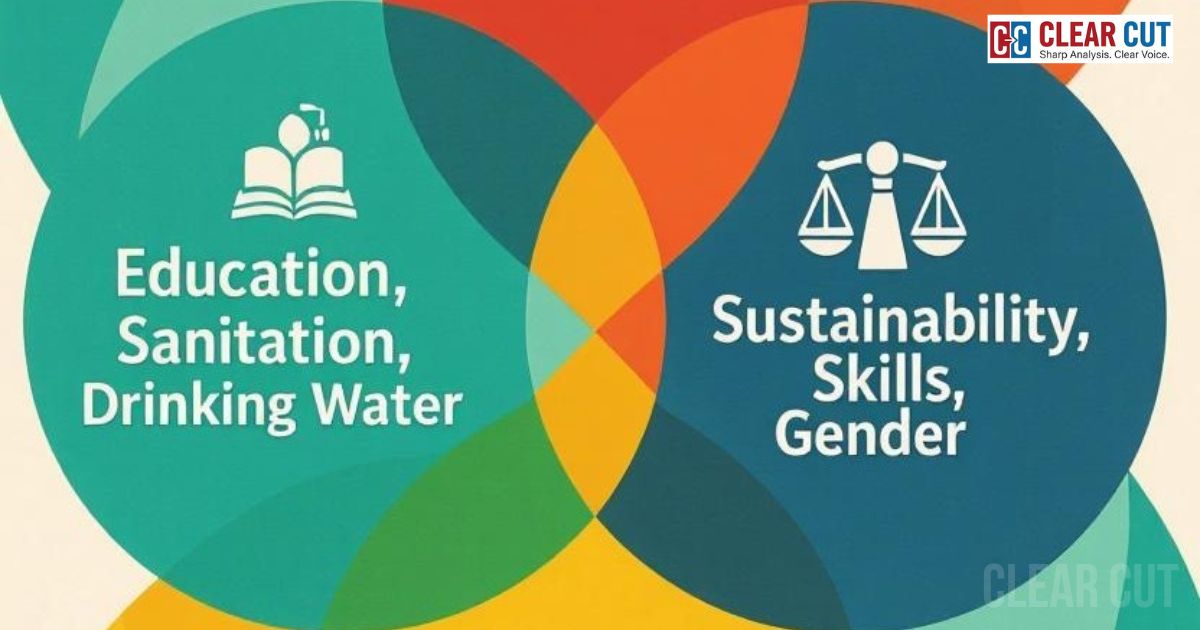Photo Credit: Antara Mrinal
Clear Cut Livelihood Desk
New Delhi, UPDATED: Sep 26, 2025 02:15 IST
Written By: Antara Mrinal
When the Geological Survey of India (GSI) launched a new Handbook on the ‘Geological Potential of Northeast India’ at the North East Mining Ministers’ Conclave, held in June 2025, the announcement was met with positive reactions from far beyond Shillong, where the meeting was staged. For the first time, the region’s mineral wealth, as reported in GSI’s Handbook, was presented in figures that astonished policymakers, investors and the interested public: over 70 million tonnes of material minerals, involving rare earth elements (REEs), graphite, vanadium, nickel, cobalt and even some preliminary signs of lithium.
Mainstream media carried headlines such as “Northeast India Holds Key to Future Mineral Security” (Economic Times, Sept 5, 2025). However, numbers tell an incomplete story, a story that begs for more profound dialogue – about the geology, about development, and about the dilemma in a fragile and resource-rich territory.
The Geological Goldmine beneath Our Feet
Although often recognized for its biodiversity and its cultural diversity, the Northeast is also a host to some of the rarest rocks in India. The Sung Valley in Meghalaya, a carbonatite-alkaline complex (a rare type of rock system formed deep inside the Earth, rich in unusual minerals, and often containing valuable elements like rare earths), and the geology of which has been researched for decades, is known for its host of unique minerals. Furthermore, as shown previously in peer-reviewed research, it contains REE mineralization, which is of importance for everything from smartphones to alternative energy and military technologies (Chakrabarti & Lehmann, Minerals, 2021).
In Assam, Karbi Anglong hosts ultramafic-mafic complexes (a group of very dark, heavy rocks from Earth’s deep interior, often rich in iron, magnesium, and sometimes valuable metals like nickel or chromium), including the Jasra (alternatively, Jashora) alkaline complex. Research (Chattopadhyay et al., Journal of Asian Earth Sciences, 2007) has established the geological viability of REE mineralization here as recorded in the GSI’s report that the REE-bearing rock is close to 28.6 million tonnes.
Arunachal Pradesh is another player on the scene. At Lodoso (Pakke Kessang district), the GSI estimates ferruginous phyllites (fine-grained, layered metamorphic rocks rich in iron) enriched in REEs to total about 2.15 – 2.2 million tonnes. At the same time, the state is reporting major occurrences of graphite (almost 18 – 25 million tonnes) and vanadium (13 – 17 million tonnes) that are already making headlines. The statements echo earlier scientific observations of vanadium-bearing black shales in the area (Das Sharma & Misra, Exploration and Research for Atomic Minerals, 2001).
The more tantalizing, there has been anecdotal evidence of the likelihood of lithium brines (saltwater solution that contains dissolved lithium) in Arunachal, Nagaland, and Assam. There are no peer-reviewed studies to date that indicate commercial deposits of lithium brine, but India’s energy transition will demand lithium, and that alone should warrant attention to the possibilities of brines in these states even if preliminary information.
Why This Matters Now
The finding of such significant amounts of critical minerals in the Northeast might be a game changer. Currently, India is importing most of its REEs from China, which dominates 60-70% of the entire global supply of these minerals. For a country promoting renewable energy, electric mobility, and advanced manufacturing, a domestic supply of REEs, graphite, vanadium, nickel, and cobalt is a strategic necessity.
The government’s sense of urgency is clear. The Ministry of Mines has already stated that these critical minerals are needed for the economic and security future of India. The Northeast could soon fulfill a primary role in India’s mineral self-sufficiency strategy through quarrying for the REE. But the narrative is not only about numbers of resources. The deeper issue is what does this mean for the land, people, and future of the Northeast?
What Extraction Could Bring
On one hand, mineral extraction could bring infrastructure, jobs, and revenue to states that frequently feel left out of India’s narrative of economic growth. Localities like Pakke Kessang, Karbi Anglong, or Sung Valley could witness schools, hospitals, and industries popping up around the new mines.
On the other hand, the Northeast has a history of ecological fragility. It contains some of the most diverse forests, rivers, and biodiversity in the world. Large-scale extraction presents genuine risk:
- Deforestation and habitat loss: Many mineralized areas are located in forested regions. What happens when extraction begins at scale?
- Cultural and community displacement: Indigenous groups have deep ties to the land. Will mining respect traditional land rights, or disrupt lives and safety in the name of development?
- Water and soil contamination: REE and vanadium mining often involves chemicals that could seep into rivers like the Brahmaputra, already under stress from erosion and floods.
- Geopolitical sensitivity: The Northeast borders Bhutan, China, and Myanmar. Will mining activities attract unwanted tensions, especially around strategic minerals?
- Natural disasters: Quarrying in ecological sensitive and geologically complex zones may increase the chances of natural disasters, or rather, human-made disasters, without balanced approaches.
These are not hypothetical fears. Similar stories have played out worldwide. In Inner Mongolia, China’s REE mining has left behind toxic lakes. In Africa, cobalt mining has raised concerns of exploitation and environmental destruction. Can India learn from these cautionary tales?
Voices from Science and Policy
Researchers warn that numbers alone do not equal mines. As Dr. Tapan Chakrabarti explains in his work on the Sung Valley, the mineralization needs to be carefully evaluated for economic potential, environmental cost and mitigation, and sustainable extraction methods. GSI’s tonnage estimates reflect an exploration stage, and until there is significant drilling, feasibility, and community consultation, there will be no single mine opened.
Policy experts have also discussed balanced approaches for longer sustainability. The government has designated some areas for rare earth elements in the Northeast as “strategic interest areas,” however, experts recommend a model of local governance, compensation, and funding for green mining innovations.
The 2025 handbook may represent the historical moment India finally acknowledges the Northeast as a region of mineral wealth and opens a new series of dilemmas. The Northeast finds itself at a crossroads: Will it become a critical mineral supply region for India’s transition to green, or will we see an extractive gold rush that devastates their lands and communities?
For the everyday person, this narrative is uplifting and sobering. The smartphone in your pocket, the solar panel on your roof, the electric car you’re dreaming of one day may actually be powered by minerals from Meghalaya, Assam, or Arunachal. Meanwhile, the beautiful hills and rivers that are the gift of Northeast India could experience the brunt of this insatiable resource appetite. The Northeast’s hidden treasure is real. The real question is: will India mine it responsibly?




